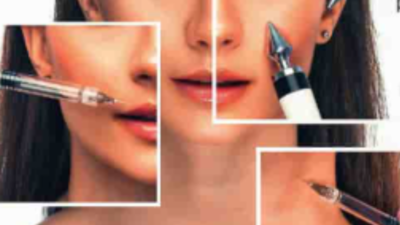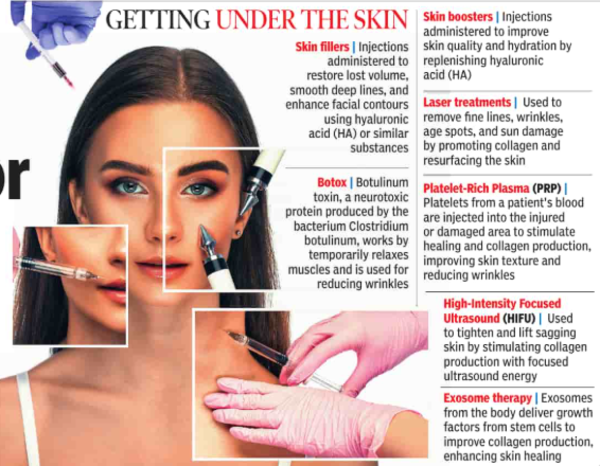ARTICLE AD BOX

HYDERABAD: In Hyderabad, twenty-somethings are queuing up for fillers, boosters, and futuristic therapies, with little regard for long-term consequences. Beauty, it seems, is no longer about ageing gracefully, but preventing age from showing up altogether, finds Ajay TomarWeeks before her wedding, Latha (name changed) visited a Banjara Hills-based clinic to enhance her appearance for her big day.The bride-to-be underwent several non-surgical aesthetic treatments such as dermal fillers to correct the asymmetry in her lips, enhance the defi nition of her nose bridge, and sharpen her jawline for a slimmer facial profile. She also went for additional fi llers in her cheekbones to add contour as she felt it would highlight her natural features.

Ditto for Seetha, who trooped into a Madhapur-based clinic to fi x what she felt was sagging skin that made her look older than her age.
She opted for a combination of high-intensity focused ultrasound (HIFU) and botox injections to relax and slim her lower face to get a youthful appearance in a jiffy.Shockingly, neither Latha nor Seetha are battling midlife crises. While Latha is a 20-something, Seetha is in her early 30s.Increased accessWhile the adage -‘Age is just a number’ – seems to no longer be the preserve of age-defying celluloid stars like Anil Kapoor, Nagarjuna, Madhuri Dixit and Preity Zinta, plastic surgeons point to an alarming trend – youngsters unhappy with their looks making a beeline for quickfi x anti-ageing procedures.
Be it skin boosters, fi llers, botox shots, laser treatments or even newer procedures, skin specialists say conscious youngsters are increasingly opting for minimally invasive and non-invasive skin prejuvenation and regeneration treatments in their quest to delay signs of ageing even before they show up.Cosmetology and dermatology clinics report that while about a decade ago, only about six to seven people would turn up for such procedures each week, all of them in the 40-plus bracket.
Today, the number has shot up three to four times with most of them being youngsters.“Around eight to 10 years ago, most of our clients were in their 40s and above when wrinkles and skin sagging usually start showing. But now many in their mid-20s and early 30s are coming in to demand ageing prevention treatments,” says senior plastic surgeon Dr Priti Shukla.“A lot of the damage is already done by the time signs of ageing appear on the skin,” she adds.Pre-emptive de-ageing

Apart from the smaller procedures, some are even opting for advanced treatments such platelet-rich plasma (PRP) therapy, HIFU, hybrid laser treatments and regenerative procedures such as exosome therapy that uses stem cells to improve collagen production, PDRN (polydeoxyribonucleotide) therapy and nano-fat grafting.Data too seems to back this emerging trend. US-based market research fi rm Grand View Research pegs the Indian anti-ageing market at $2.5 billion in 2024 and projects it to reach $4 billion by 2033.So what is driving youth to such extremes in their pursuit for beauty? In an era of intense social media engagement and peer pressure, where the perfect selfi e and number of likes dictate the happiness quotient for many, the quest for that seductive pout or perfectly sculpted nose, well defi ned chin or jawline, or fi ne skin tone and perfect glow are pushing them to seek anti-ageing remedies. The supply surge also led to treatments becoming more affordable with costs varying from just Rs 5,000 to Rs 40,000 per session.“Over the past decade, there has been a rise in active social media presence and the culture of photo and video sharing, prompting individuals to observe their skin more closely and be critical about it,” explains plastic surgeon Dr Sumeera Farhath SK.Studies also point to the rising popularity of South Korean television shows, which frequently portray skincare as a daily routine, among Indian youth as a signifi cant factor infl uencing their growing interest in cosmetics and skincare.
Notably, South Korea is the world leader in cosmetic treatments and plastic surgery.Senior psychologist Dr Pragya Rashmi says starting cosmetic enhancements at an early age could also be an indicator of one’s poor perception of self-esteem and body image.Flawed beauty standardsConsultant psychiatrist and lifestyle expert Dr Purnima Nagaraja points out that most opt for cosmetic enhancements due to a distorted sense of one’s own body image. “There is a significant difference between how people actually look and what society expects from them. Many individuals try to live up to the image of a perfect body, fl awless hair, and ideal shape. This constant pressure is what drives many to go for cosmetic procedures.”



.png)
.png)
.png)
















 2 hours ago
5
2 hours ago
5









 English (US) ·
English (US) ·